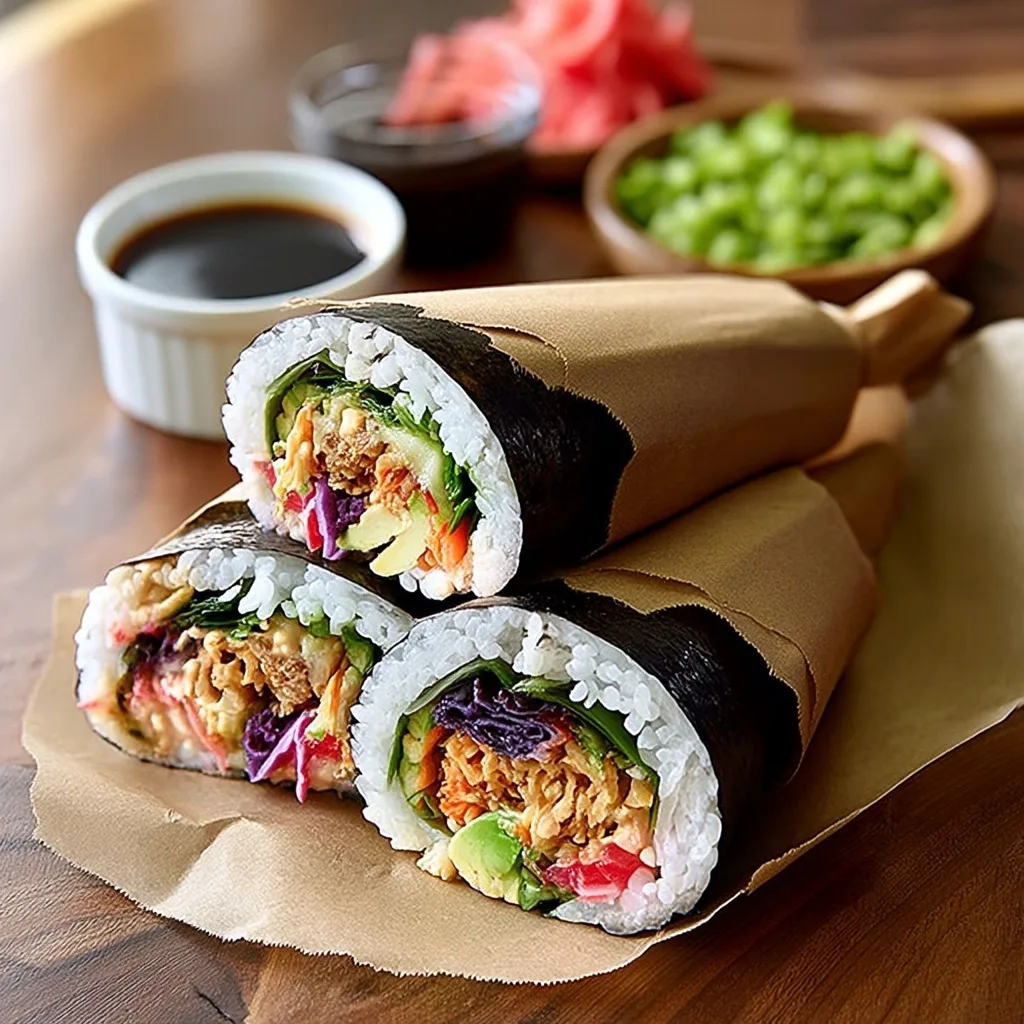When East meets West in the most delicious way possible, you get the incredible sushi burrito – a game-changing fusion dish that’s taken the culinary world by storm. This isn’t just another trendy food mashup; it’s a legitimate revolution that combines the fresh, clean flavors of traditional sushi with the hearty, satisfying format of a burrito.
Furthermore, the sushi burrito represents everything we love about modern cooking – innovation, accessibility, and downright deliciousness all rolled into one magnificent package. Plus, it’s surprisingly easy to make at home, which means you can enjoy restaurant-quality fusion cuisine without breaking the bank or leaving your kitchen.
What Makes a Sushi Burrito So Special
There’s something absolutely magical about taking two beloved food formats and creating something entirely new yet familiar. The sushi burrito accomplishes this feat brilliantly by maintaining the fresh, clean flavors of traditional sushi while providing the substantial, handheld convenience of a burrito.
Unlike traditional sushi rolls that require precise cutting and delicate handling, the sushi burrito embraces a more casual, approachable format. Moreover, it allows for much more generous portions of filling, making it a truly satisfying meal rather than just an appetizer or light snack.
What sets the sushi burrito apart from other fusion foods is its perfect balance of textures and flavors. The tender sushi rice provides a neutral base, while fresh vegetables add crunch and color. Meanwhile, high-quality fish delivers that essential umami richness that makes every bite memorable.
The History and Rise of Sushi Burritos
The sushi burrito phenomenon began in California, specifically in the San Francisco Bay Area, where innovative chefs started experimenting with traditional Japanese techniques and Mexican-inspired presentation. This fusion concept quickly gained traction because it solved several practical problems with traditional sushi consumption.
Accessibility: Traditional sushi can be intimidating for newcomers, but the burrito format feels familiar and approachable to almost everyone. Additionally, it doesn’t require chopsticks or special eating techniques.
Portability: Unlike traditional sushi rolls that require careful handling and plates, the sushi burrito can be eaten on the go, making it perfect for busy lifestyles and casual dining situations.
Customization: The larger format allows for more ingredients and creative combinations that wouldn’t fit in traditional maki rolls. Consequently, diners can create personalized flavor profiles that suit their specific tastes.
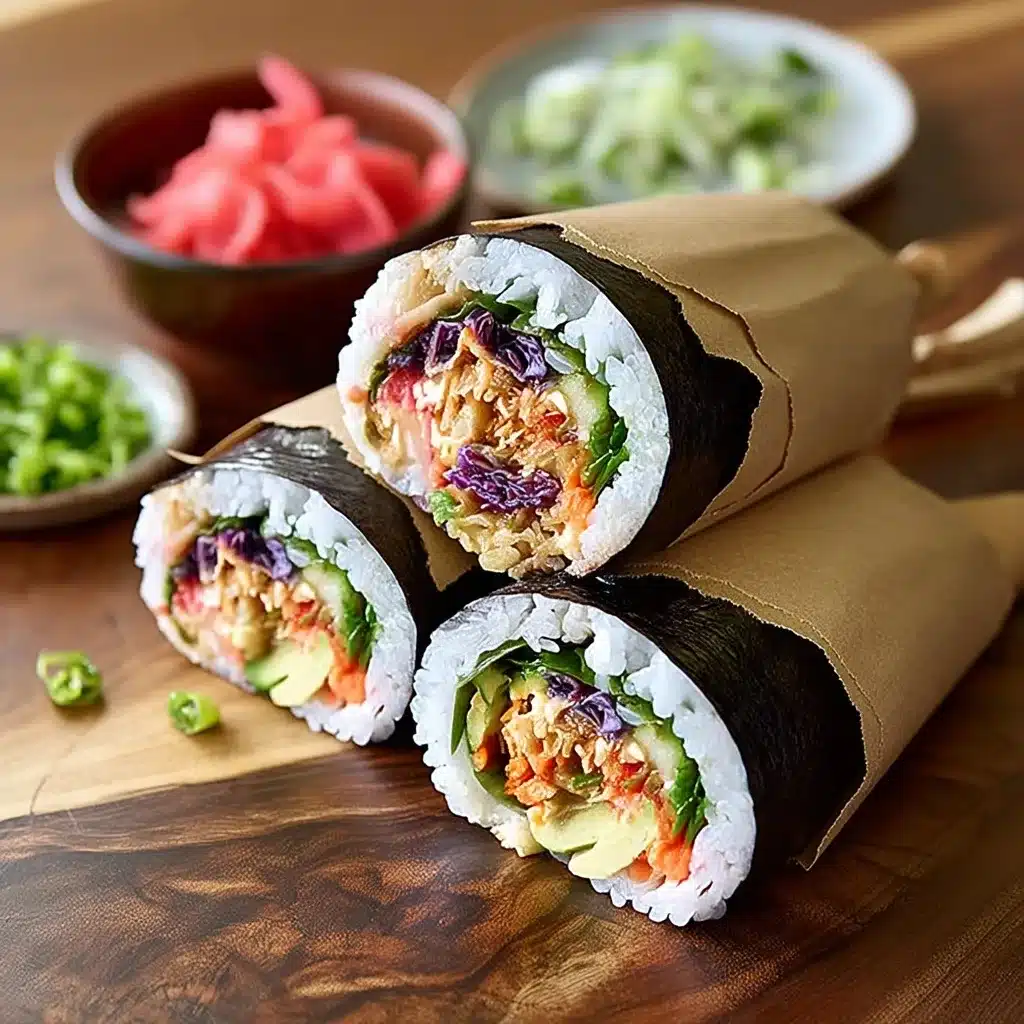
Essential Ingredients for the Perfect Sushi Burrito
The Foundation: Sushi Rice
Quality sushi rice forms the foundation of any great sushi burrito. Short-grain Japanese rice has the perfect sticky texture that holds everything together while providing a neutral flavor base. Furthermore, proper seasoning with rice vinegar, sugar, and salt creates that distinctive sushi taste we all crave.
Rice Preparation Secrets: The key to perfect sushi rice lies in the washing process. Rinse the rice until the water runs clear, then cook with the precise water ratio. Once cooked, season while warm for optimal flavor absorption.
Premium Fish Selection
Sushi-Grade Standards: When making a sushi burrito, never compromise on fish quality. Sushi-grade tuna or salmon ensures both safety and optimal flavor. These fish have been handled and frozen according to strict standards that eliminate parasites while preserving texture and taste.
Preparation Techniques: Slice fish against the grain in thin, uniform pieces. This technique ensures tender bites and even distribution throughout the burrito. Additionally, proper knife skills make a significant difference in the final texture.
Fresh Vegetable Components
Cucumber: Provides essential crunch and freshness that balances the rich fish. Julienne cutting creates uniform pieces that distribute evenly and won’t overpower other ingredients.
Carrots: Add sweetness and vibrant color while contributing additional crunch. Similarly, julienne cutting ensures consistent texture throughout the sushi burrito.
Avocado: Contributes creamy richness that binds flavors together. Choose ripe but firm avocados that won’t turn mushy during assembly.
Red Cabbage: Offers additional crunch and beautiful purple color that makes the burrito visually striking. Moreover, cabbage provides subtle peppery notes that complement the fish.
Step-by-Step Assembly Guide for Sushi Burrito Mastery
Setting Up Your Workspace
Before beginning assembly, organize all ingredients and tools within easy reach. This mise en place approach ensures smooth assembly and prevents the nori from drying out during construction.
Essential Tools: A bamboo sushi mat makes rolling much easier, but parchment paper works as an effective substitute. Additionally, keep a bowl of water nearby for moistening hands and sealing the nori.
The Foundation Layer
Lay the nori sheet shiny-side down on your bamboo mat or parchment paper. This orientation ensures the smooth side faces outward on the finished sushi burrito, creating an attractive presentation.
Rice Distribution: Wet hands prevent rice from sticking to fingers during spreading. Apply gentle, even pressure to create a uniform layer while leaving that crucial inch border at the top for sealing.
Strategic Ingredient Placement
Central Loading: Place all fillings in a concentrated line down the center of the rice. This technique ensures even distribution throughout the sushi burrito and prevents ingredients from sliding around during rolling.
Layering Order: Start with fish, then add vegetables in order of firmness – cucumbers and carrots first, followed by softer ingredients like avocado. Finally, add cabbage and scallions for textural contrast.
The Rolling Technique
Initial Wrap: Begin rolling from the bottom edge, using the mat or parchment to guide the motion. Apply gentle but consistent pressure to create a tight roll without squeezing out ingredients.
Sealing Process: Wet the exposed nori edge slightly and complete the roll. The moisture activates the nori’s natural adhesive properties, creating a secure seal that won’t unravel.
Advanced Techniques for Professional Results
Rice Texture Optimization
Temperature Matters: Use room-temperature seasoned rice for optimal handling and flavor. Hot rice will wilt vegetables and make rolling difficult, while cold rice becomes hard and doesn’t stick properly.
Seasoning Balance: The rice seasoning should be subtle but noticeable. Too much vinegar overpowers other flavors, while too little makes the rice taste bland and one-dimensional.
Sauce Integration Strategies
Spicy Mayo Placement: Apply sauce in thin lines rather than dollops to ensure even distribution. This technique prevents sauce-heavy and sauce-light sections in your sushi burrito.
Alternative Sauces: Consider eel sauce, ponzu, or sriracha aioli for different flavor profiles. Each sauce brings unique characteristics that can completely transform the eating experience.
Vegetable Preparation Excellence
Uniform Cutting: Consistent julienne cuts ensure even cooking and distribution. Additionally, uniformly cut vegetables create a more professional appearance and better texture balance.
Moisture Management: Pat vegetables dry before assembly to prevent soggy nori. Excess moisture is the enemy of crispy nori texture and structural integrity.
Nutritional Benefits of Sushi Burritos
Complete Protein Source
The fish in a sushi burrito provides high-quality complete protein containing all essential amino acids. Moreover, fish like tuna and salmon offer omega-3 fatty acids that support heart and brain health.
Caloric Content: A typical sushi burrito contains 400-500 calories, making it a substantial but not excessive meal. The combination of protein, complex carbohydrates, and healthy fats provides sustained energy.
Vegetable Nutrition
Antioxidant Power: The variety of colorful vegetables provides diverse antioxidants that combat inflammation and support overall health. Furthermore, the raw preparation preserves heat-sensitive vitamins.
Fiber Content: Vegetables and brown rice options add significant fiber, supporting digestive health and providing satiety that helps control portion sizes.
Healthy Fats
Avocado Benefits: The avocado in a sushi burrito provides monounsaturated fats that support heart health and help absorb fat-soluble vitamins from other ingredients.
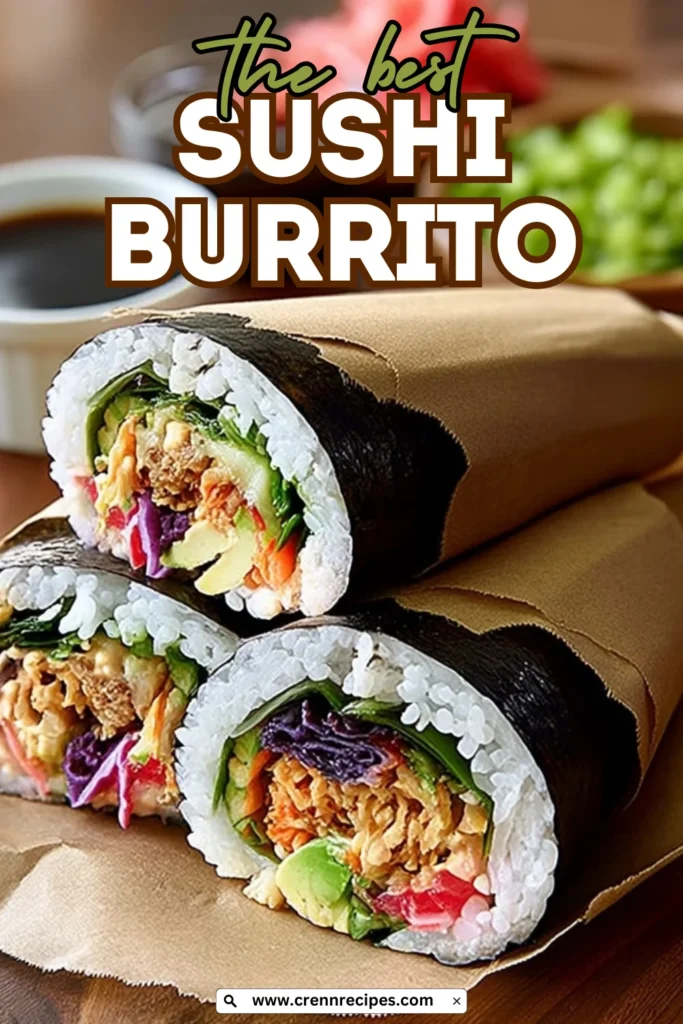
Creative Variations and Customizations
Protein Alternatives
Cooked Options: For those preferring cooked fish, tempura shrimp, grilled chicken teriyaki, or even tofu provides excellent alternatives while maintaining the Asian flavor profile.
Vegetarian Versions: A veggie sushi burrito loaded with cucumber, avocado, carrots, sprouts, and marinated tofu offers satisfying plant-based nutrition without sacrificing flavor.
Sauce Innovations
Fusion Flavors: Experiment with Korean gochujang mayo, Thai sweet chili sauce, or Vietnamese nuoc cham for international flavor twists that complement the base ingredients.
Homemade Creations: Creating custom sauce blends allows for personalized flavor profiles. Consider combining miso paste with mayo and lime for umami richness.
Seasonal Adaptations
Summer Variations: Include fresh corn, cucumber ribbons, or stone fruit for seasonal freshness. These ingredients add sweetness and crunch that complement summer dining.
Winter Modifications: Incorporate roasted vegetables or warm elements like tempura for comfort food appeal during colder months.
Storage and Make-Ahead Strategies
Component Preparation
Advance Prep: Rice can be prepared a day ahead and stored refrigerated. Vegetables can be julienned and stored separately to maintain crispness. However, assemble the sushi burrito immediately before serving for best texture.
Storage Solutions: If you must store assembled burritos, wrap tightly in plastic wrap and consume within 24 hours. The nori will soften over time, but the flavors often improve with brief marination.
Travel Considerations
Portable Packing: Wrap individual sushi burritos in parchment paper for easy transport. This method maintains structure while allowing for comfortable handheld eating.
Temperature Control: Keep refrigerated until serving time, then allow to come to room temperature for 10-15 minutes before eating for optimal flavor development.
Serving Suggestions and Presentation Ideas
Traditional Accompaniments
Classic Sides: Serve your sushi burrito with traditional accompaniments like pickled ginger, wasabi, and high-quality soy sauce or tamari for gluten-free options.
Modern Additions: Consider adding edamame, seaweed salad, or miso soup for a complete Japanese-inspired meal experience.
Presentation Techniques
Cutting Styles: Slice the burrito diagonally to showcase the colorful interior, or leave whole for casual handheld eating. Both approaches have their merits depending on the dining occasion.
Plating Ideas: Present on wooden boards or black plates to emphasize the Japanese aesthetic. Additionally, garnish with sesame seeds, scallions, or microgreens for restaurant-quality presentation.
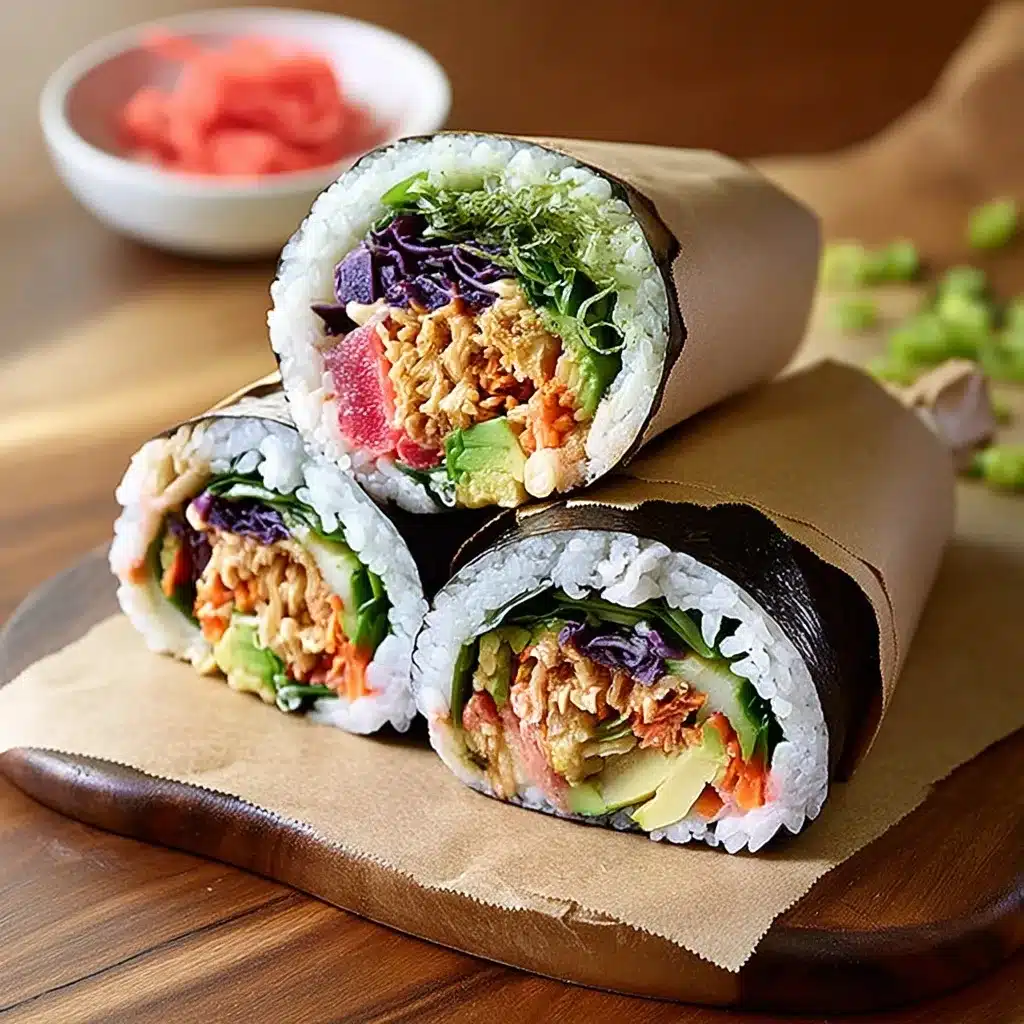
Troubleshooting Common Issues
Structural Problems
Rolling Challenges: If your sushi burrito won’t stay closed, you likely used too much filling or didn’t wet the sealing edge adequately. Practice with smaller amounts until you develop the proper technique.
Soggy Nori: Prevent soggy nori by ensuring all vegetables are properly dried and avoiding over-saucing. Additionally, consume assembled burritos promptly for optimal texture.
Flavor Balance Issues
Overwhelming Fish: If the fish flavor dominates, increase vegetable quantities or add more rice to balance the protein intensity. The goal is harmony among all components.
Bland Results: Under-seasoned rice is often the culprit. Ensure proper vinegar seasoning and don’t forget to salt vegetables lightly for flavor enhancement.
Cultural Appreciation and Fusion Ethics
Respectful Innovation
Creating a sushi burrito represents cultural fusion at its best when done respectfully. Understanding traditional sushi techniques and ingredients ensures authentic flavor development while embracing innovation.
Quality Standards: Maintaining high-quality ingredients and proper techniques honors both Japanese and Mexican culinary traditions that inspire this fusion creation.
Educational Opportunities
Cultural Learning: Making sushi burritos provides opportunities to learn about Japanese ingredients, techniques, and flavor principles. This knowledge enhances appreciation for traditional cuisine.
More Related Recipes You Might Enjoy
If you’re excited about this sushi burrito recipe, you’ll love exploring these other creative culinary adventures:
- Christmas Maraschino Cherry Shortbread – A delightful sweet treat that showcases creative ingredient combinations, perfect for special occasions
- Cottage Cheese Chips – An innovative snack that transforms simple ingredients into something extraordinary, ideal for creative cooking enthusiasts
- Peach Ice Cream – A fresh, homemade dessert that celebrates natural flavors and hands-on cooking techniques
Equipment and Tool Recommendations
Essential Equipment
Bamboo Mat: While not absolutely necessary, a bamboo sushi mat makes rolling significantly easier and produces more consistent results. The flexible slats provide excellent control during the rolling process.
Sharp Knife: A very sharp knife is crucial for clean cuts through the nori without tearing. Additionally, a sharp blade prevents ingredients from being pushed out during slicing.
Optional Upgrades
Rice Cooker: Consistent rice texture is crucial for sushi burrito success. A quality rice cooker eliminates guesswork and produces perfect results every time.
Mandoline Slicer: For perfectly uniform vegetable julienne, a mandoline slicer provides professional results with minimal effort and time investment.
Safety Considerations When Working with Raw Fish
Source Selection
Reputable Suppliers: Only purchase sushi-grade fish from trusted fishmongers or specialty stores. These suppliers understand proper handling and freezing requirements for raw consumption safety.
Freshness Indicators: Fresh fish should smell like the ocean, not “fishy.” The flesh should be firm, bright in color, and free from any slimy texture or off-odors.
Handling Protocols
Temperature Control: Keep fish refrigerated until immediately before use. Additionally, prepare and consume the sushi burrito promptly after assembly to minimize safety risks.
Cross-Contamination Prevention: Use separate cutting boards and knives for fish and vegetables. Wash hands thoroughly between handling different ingredients.
Final Thoughts on Sushi Burrito Mastery
The sushi burrito represents everything exciting about modern fusion cuisine – creativity, accessibility, and absolutely delicious results. It proves that innovation doesn’t require abandoning tradition; instead, it can honor and enhance classic techniques while creating something entirely new.
What makes the sushi burrito particularly special is its democratic nature. Unlike traditional sushi that requires years of training to master, this fusion creation welcomes experimentation and personal interpretation. Every home cook can create their perfect version based on available ingredients and personal preferences.
The beauty of this recipe lies not just in its delicious results, but in the creative process itself. Building a sushi burrito encourages mindful ingredient selection, careful technique development, and artistic presentation. Moreover, it provides an excellent introduction to Japanese flavors and techniques for those new to this cuisine.
Don’t be intimidated by the fusion concept or the raw fish component. Start with high-quality ingredients, follow proper techniques, and trust the process. Your first sushi burrito might not look perfect, but it will certainly taste amazing and provide valuable learning experience for future attempts.
Most importantly, have fun with the process. Cooking should be enjoyable, and the sushi burrito embodies this philosophy perfectly. Experiment with different vegetables, try various sauces, and create combinations that excite your palate.
Whether you’re making lunch for yourself, impressing dinner guests, or introducing family members to new flavors, the sushi burrito delivers on every level. It’s healthy, satisfying, visually stunning, and absolutely delicious – everything we want in modern home cooking.
Print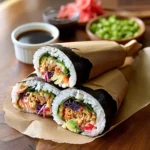
Sushi Burrito: Amazing Homemade Recipe
- Total Time: 50 minutes
- Yield: 4 burritos 1x
Description
A delicious fusion dish combining the fresh flavors of Japanese sushi with the convenient handheld format of a Mexican burrito. Features sushi-grade fish, crisp vegetables, and seasoned sushi rice wrapped in nori seaweed.
Ingredients
- 2 cups sushi rice, cooked and seasoned with rice vinegar, sugar, and salt
- 4 large sheets of nori (seaweed)
- 1/2 lb sushi-grade ahi tuna or salmon, thinly sliced
- 1/2 cup julienned cucumber
- 1/2 cup julienned carrots
- 1 avocado, sliced
- 1/2 cup shredded red cabbage
- 1/4 cup chopped scallions
- 1/4 cup spicy mayo (mayo + sriracha to taste)
- Soy sauce or tamari, for dipping
- Pickled ginger, optional
- Bamboo sushi mat or parchment paper
Instructions
- Lay It All Out: Place nori sheet on bamboo mat or parchment paper, shiny side down.
- Spread the Rice: With wet hands, spread thin, even layer of sushi rice over nori, leaving 1-inch border at top.
- Pile on the Good Stuff: Layer tuna or salmon, cucumbers, carrots, avocado, cabbage, and scallions down the center. Drizzle with spicy mayo.
- Time to Roll: Roll tightly using mat or paper to help. Press gently as you go. Wet nori edge to seal.
- Let It Rest: Allow burrito to rest briefly so nori softens and holds together.
- Slice or Wrap: Cut in half or wrap in parchment for handheld eating.
- Serve It Up: Plate with soy sauce, pickled ginger, and wasabi if desired.
Notes
- Only use sushi-grade fish from reputable suppliers for safety
- Keep fish refrigerated until immediately before use
- Wet hands when handling sushi rice to prevent sticking
- Can substitute cooked shrimp or tofu for raw fish alternatives
- Best consumed immediately after assembly for optimal texture
- Prep Time: 20 minutes
- Cook Time: 20 minutes (for rice)
- Category: Lunch, Dinner, Fusion
- Method: Rolling, No-Cook Assembly
- Cuisine: Japanese-Mexican Fusion
Nutrition
- Serving Size: 1 burrito
- Calories: 450
- Sugar: 12g
- Sodium: 820mg
- Fat: 16g
- Saturated Fat: 3g
- Unsaturated Fat: 12g
- Trans Fat: 0g
- Carbohydrates: 55g
- Fiber: 4g
- Protein: 20g
- Cholesterol: 35mg

